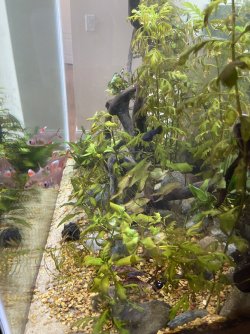I don't know. The serpais might be well behaved now. But that might change when they see the ventral fins of a gourami.
This is a very real issue. It is scientific fact that a shoaling fish in groups of three and five is almost guaranteed to be more aggressive than it normally would be in a group of ten. Here we have a naturally aggressive species that has been kept in a group of four. The liklihood of these fish suddenly turning is very real.
Why a fish may not behave according to its natural inherent behaviours is not always easy to ascertain. We know that in the circumstance I just mentioned, the fish in the smaller groups
do become more aggressive. Why they have not done so yet, no one knows. Animals are like that, they can be affected by any number of things, resulting in non-normal behaviour. It is always the wisest course to assume the norm for a species, not hope that for some reason it will be abnormal. The temperature range for Hyphessobrycon eques is 22-28C/72-82F, and some sources report less fin nipping issues with temperatures in the lower end of the stated range.
Native to South America, this species is found over a wide geographical area of the Amazon, Parana, Guapore and Paraguay River basins. This citation from my profile may provide some suggestions of all this.
This species is readily discerned from all the other rosy tetra species by the dark colour pattern on the posterior part of the anal fin that expands from the black distal (furtherest from the body) border of this fin. Weitzman & Palmer (1997) note that this dark pattern is somewhat variable on wild-caught specimens from different locations [see below].
Behaviour can be unpredictable; keeping the species in large groups and in larger tanks tends to lessen its aggressiveness. This variant behaviour, like the anal fin pattern mentioned above, may also partly be due to significant variations between the fish. The species has a large geographical distribution including areas of the Amazon, Parana, Guapore and Paraguay River basins. Dr. Stanley Weitzman (1997) has suggested that the "species" may be a complex of closely related species that are geographically quite variable over this wide area of Amazonia; it is quite possible that this "species" may actually be several different species, each endemic to specific river basins, but this will only be ascertained after collections from many locations have been studied in detail.
Most of the fish now available in the hobby are commercially raised and differ from wild-caught fish with respect to the dark shoulder or humeral patch. Commercially bred fish are descended from hybrids (perhaps unintentionally) of fish from different geographical areas, and the patch is shorter or all but absent on most; on wild-caught fish, this patch is black, elongate and slightly triangular. This decades-long inbreeding may also partly explain the fish's aggressive nature.



